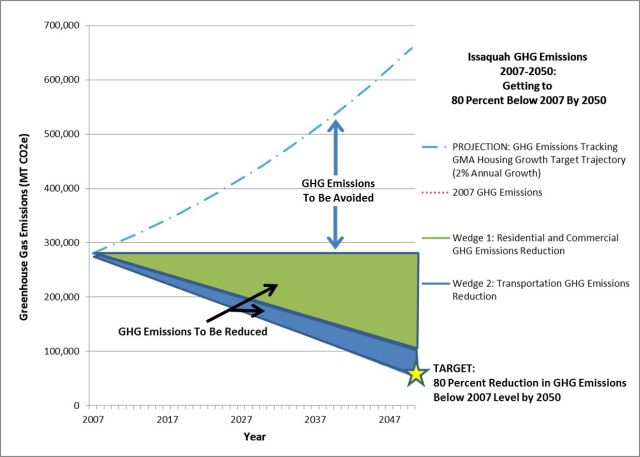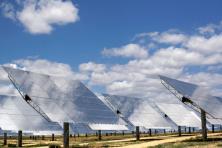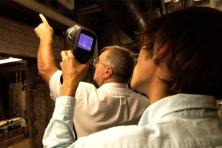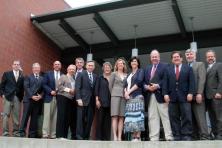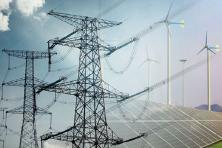Working with numerous Northwest cities over the past four years, the New Energy Cities team has learned many lessons about how cities can accelerate the adoption of climate-smart, clean energy solutions. However, none was more instructive than the need for setting a clear, aggressive greenhouse gas (GHG) emissions reduction with metrics. I know how process-heavy this sounds, but stay with me because this is really important.
Having your community aim at a clear and measurable emission reduction target—such as the City of Issaquah’s goal to reduce community-wide carbon emissions to 80 percent of 2007 levels by 2050—will drive decisions about climate action strategies in a coherent fashion, provide the basis for tracking and measuring progress, and encourage critical community buy-in around a defined outcome.
Once a community has set an emissions reduction target with interim goals, the policies, programs, and projects that roll up to achieve the targets are possible. Also setting an overarching emissions reduction target paves the way for communities to do the carbon math needed to drive sustainable energy strategies. (Doing carbon math is actually a lot of fun. I know you don’t believe me so read New Energy Cities Doing Carbon Math to see why I say this.)
How to Set Emissions Targets
Emission reduction targets should be: (1) aggressive but realistic; (2) measurable; (3) community-specific. Here’s how your community should go about setting an emissions target:
- Choose a base year from which your community target will be reduced, ideally one for which you have emissions data. If you do not have baseline emissions data, you can create a target that says you will reduce by a certain percentage below current levels by a certain year, measure your current emissions, and go from there.
- Review the current science about the reduction levels that are needed to address dangerous concentrations of atmospheric GHG, as well as air pollutants. (See below for what the climate science indicates you must shoot for).
- Research your state and/or regional emissions targets so your community target either rolls up into those broader targets, or exceeds them. (See below for a discussion of WA and OR targets)
- Review targets that other communities have set to get ideas for setting a target for your community. (See below for a chart on all US city and international targets).
- Set the time frame with short-term (i.e., five-year); medium-term (15-year); long-term (30-40 year) goals. An example of this is California’s reduction targets set June 1, 2005:
- Short: Reduce emissions to 2000 levels by 2010
- Medium: Reduce emissions to 1990 levels by 2020
- Long-term: Reduce emissions 80% below 1990 levels by 2050
- Each community will handle its political process for approving the target and the plan for engaging the community differently: some will have their city of county council set and approve the target; others will take the decision to the community before the council approves the target. We have worked with both and neither is right nor wrong. What matters is doing what works for your particular community.
Climate Science
Scientists generally agree that in order to stabilize the Earth’s climate, we must reduce GHG emissions a minimum of 80% below 1990 levels. Here’s where things stood in 2010 according to ICLEI, the international clearinghouse for local level sustainable development and environmental policies:
“There is growing consensus among climate scientists that in order to avoid the most dangerous future climate change scenarios, the global concentration of greenhouse gases needs to stabilize at 450 parts-per-million by volume (ppmv) CO2e by mid-century. In order for this to happen, emissions from Western industrialized countries would need to be reduced between 25 and 40 percent below 1990 levels in 2020, and between 80 to 95 percent below 1990 levels in 2050.
This acceptable range is based on the range of error in the climate models and on the specific per capita emission levels of each country. The United States, for example, would need to reduce its emissions closer to 95% below 1990 levels, as it is one of the highest per capita emitters of CO2e in the world.”[1]
Examples of Targets
The G8 nation’s goal is 50% below 1990 levels by 2050. ICLEI’s 2010 recommendation for US community-wide reduction targets was of 80% of 1990 levels by 2050. The Center for Climate and Energy Solutions has compiled all of the U. S. state and regional targets in the United States, as well as international targets in a handy chart that you can use for reference in setting a community-wide target.
Washington and Oregon Parameters
On May 3, 2007, WA State Governor Christine Gregoire signed Substitute Senate Bill 6001, which established the statewide GHG emissions reduction goals that she had previously approved by executive order, to wit:
- By January 1, 2020, reduce GHG emissions to 1990 levels,
- By January 1, 2035, reduce emissions to 25 percent below 1990 levels, and
- By January 1, 2050, reduce emissions to the lesser of 50 percent below 1990 levels or 70 percent below the projected annual emissions level for 2050.
For additional information about Washington State’s 2010 Climate Comprehensive Plan see “Path to a Low-Carbon Economy.”
Also in 2007, the Oregon Legislature established climate change goals by passing House Bill 3543 and setting the following targets:
- By 2010, arrest the growth of Oregon’s GHG emissions and begin to reduce GHG emissions.
- By 2020, achieve GHG levels that are 10 percent below 1990 levels.
- By 2050, achieve GHG levels that are at least 75 percent below 1990 levels.
Oregon’s Global Warming Commission created Keep Oregon Cool and a Roadmap to 2050, a very good resource not only for how Oregon intends to achieve its emission reduction goals, but for general guidance on how to approach target-setting and implementation.
Once a community has set a GHG emissions reduction target, then the fun really begins!
[1] ICLEI Climate Mitigation Quick Start Guide—Establishing a Greenhouse Gas Emissions Reduction Target, p. 11.
